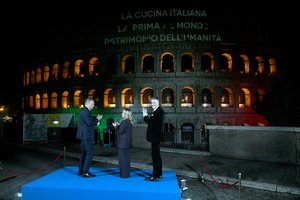The multi-billion-euro infrastructure project known as MOSE was designed in 1984 and has been underway since 2003, but has been plagued by cost overruns, corruption scandals and delays.
Prime Minister Giuseppe Conte attended the trial run on Friday and started the computerised system that sent all 78 giant yellow sluice gates rising simultaneously above the water for the first time.
Conte acknowledged the “disgraceful” corruption that had dogged the project, but said it was now time for everyone, including protesters, to look forwards.
“We all have to hope that it works,” he said.
It seems Conte’s wish came true.
“This is the first test of movement of all four barriers at the same time,” a statement said announcing the successful completion of the test.
The complex engineering system uses a network of water-filled caissons, designed to be raised within 30 minutes to create a barrier capable of resisting a water rise of three metres above normal.
Each barrier is made up of around 20 individual gates.
The project has thus far cost about €7 billion versus an original estimate of €2 billion.
The defence system – whose name is both a reference to the biblical prophet Moses who parted the Red Sea and an acronym, in Italian, for “Experimental Electromechanical Module” – is not expected to be fully functional until next year.
The project’s head, Elisabetta Spitz, said MOSE will be operational from autumn 2021, although there remains a lot of work and forthcoming tests.
Once operational, the system is designed to protect Venice from tides of up to three metres, well beyond the current record, but some experts worry it will be overwhelmed by the sort of rising seas that recent climate change models have predicted.
Venice regularly experiences “acqua alta”, abnormally high tides that flood shops and hotels as well as the famous St Mark’s Square.
The high tides are caused by a combination of factors exacerbated by climate change, from rising sea levels and unusually high tides to land subsidence that has caused the ground level of the city to sink.
The worst floods in more than 50 years left the historic St Mark’s Square submerged under a metre of water in November, causing extensive damage to the lagoon city and underlining the growing environmental threat to one of the world’s most famous cultural sites.












